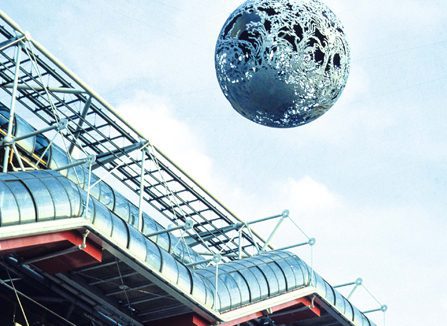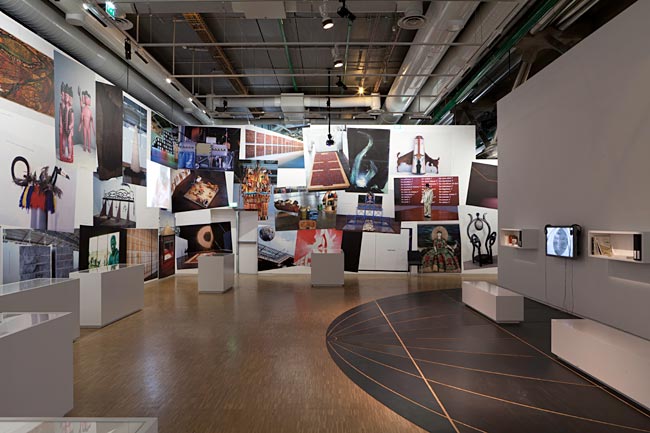 |
If I had known what I was going to see at Magiciens de la Terre: A Look Back at a
Legendary Exhibition, I wouldn’t have gone. It sounds so dull to visit an
exhibition that documents an exhibition staged in the same space twenty-five
years ago. And what might make it even more tedious is that we don’t get to see
the works themselves, but photographic and video representations of the works
and their exhibition at the Centre Pompidou and the Grand Hall at La Villette
in 1989. But, maybe because of my age, or my interest in the political potential and value of art, or maybe because I was
simply looking for a nice distraction on Friday night, I loved it!
 |
| Magiciens de la Terre: Retour sur une exposition légendaire exhibition view |
I was travelling around India when the original
Magiciens de la Terre was staged, as
the Berlin Wall fell in some distant far away land that a few months earlier
had been the center of my world. Events such as the fall of the Berlin Wall and
the eruption of student protests in Tiananman Square a few months earlier
really did change the world. Most notably, the whole notion of “the West” changed
with the erasure of the Iron Curtain.
Even though it could have been lost in
among the political turmoil of 1989, I vividly remember the excitement generated
by Magiciens de la Terre when I studied
art history the following year at Melbourne University. This was an exhibition
said to change the course of art history. There are a lot of exhibitions that
claim they will do this, but as we know, it’s really only 25 years later
that we can look back and tell how few exhibitions determine the impact of
anything in their wake. Magiciens de la
Terre was one of the few that did revolutionize.
 |
| Magiciens de la Terre: Retour sur une exposition légendaire exhibition view |
Magiciens
de la Terre, a hommage to the original, provoked me to reflect back
on the difference between art production, exhibition and understanding then and
now. Even though they were poster-type photographic reproductions of artworks from
the original exhibition, I recognized the impact they had on the way art is
made, the way we think about it, write about it and determine its value. It
seems like yesterday, but 25 years ago our whole notion of global art in the
museum was all but non-existent. And now, 25 years later, non-Western art not
only influences, but is fully integrated into the art world.
 |
| Richard Lon, Red Earth Circle, 1989 Yuendumu Community, Yam Dressing, 1989 La Villette |
Magiciens
de la Terre brought to public attention, for
example, how the motivation of non-Western art is so different. For the Australian
aborigines, for example, art belongs in their rituals, it tells their history,
is like a letter written from one generation to the next on the wall of a cave,
on the body, with a stick in the dirt. In the exhibition there were people who
used art for healing, for medicinal purposes, for masks, for religious ceremonies. Likewise, it is made to be seen from above,
to be walked on, to be used as a cultish item. Then and now, these different
uses of art open up our world, they enable us to see how small the West's conception
of art is both before and after the Magiciens de la
Terre.
The videos on display at the Centre
Pompidou reminded me that the original exhibition was also about the creation
of a community of artists; it was so much more than simply exhibiting the work. Some
artists were invited to Paris—especially those from Asia, Aboriginal
Australians, Africans—to make their art at La Villette. One of the most
touching moments in a video of the original exhibition is when three Tibetan
monks go to the Eiffel tower as tourists, having finished their ephemeral mandala.
In their quiet gentle way, the monks strike up conversation with some African
children. This meeting of two worlds at the Eiffel Tower was somehow
illustrative of the exhibition itself: different cultures coming together, peacefully,
to be together, included. There is no such thing as anger or resentment or
aggression of any kind in any of the works on display, in contradistinction to
the turmoil and upheavals earlier in the year 1989.
 |
| Barbara Kruger, Who are the Magicians of the Earth?, 1989. |
I was surprised to see so many different Western
artists who have some influence, engagement, or interest in non-Western art included
and not differentiated for their Westerness: Juan Munoz, Marina Abramovic,
Ulay, Robert Longo, Rebecca Horn, Barbara Kruger, Anselm Kiefer were some of
the names whose work was claimed to be relevant to the development of
non-Western art. While I understand why works by these artists are included, I
wondered if it distracted from the urgency of bringing other, lesser known
artists into the spotlight? I can't imagine that this was not a topic of discussion at the time.
No comments:
Post a Comment